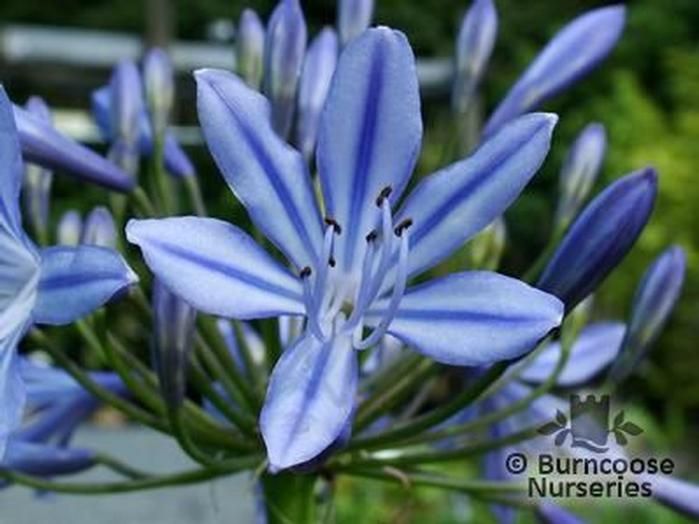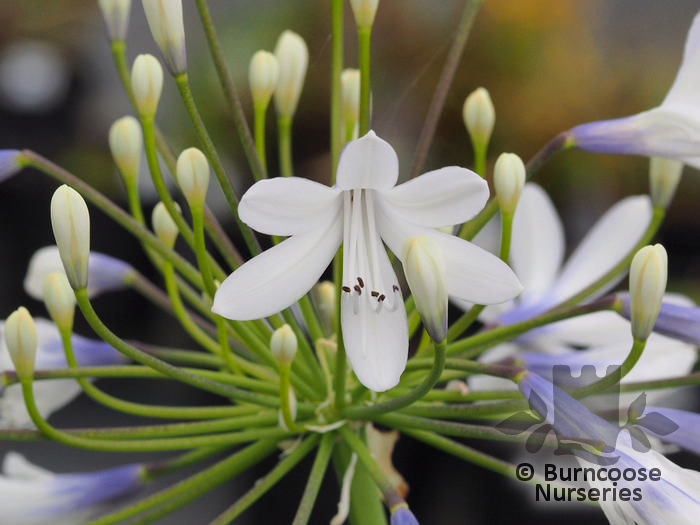- Shop Now
- Burncoose Specialities
- This Month
- Offers & Promotions
- RHS Chelsea Flower Show 2024
- 40 years at Burncoose
- Engage With Us
- Information, Help & Advice
- About Us & Our Services
- Terms & Conditions
- Log In / Register
Chapters
Agapanthus - Care Guide
Introduction
Commonly known as the African Lily.
Agapanthus are vigorous perennials with fleshy roots from South Africa. Some species are evergreen and these tend to be less hardy than those which are deciduous and die down completely over winter. The evergreen species grow in coastal areas with year round rainfall and the deciduous ones in mountain grasslands where they have dry winters and moist summers. Despite their origins in South Africa, agapanthus are in fact easy to grow in the UK given an understanding of what they like.
Planting location
Agapanthus grow best in full sun in a well drained soil. It is, however, a mistake to plant them in a position that does not have fertile soil and good moisture retention. Planting in shade will result in poor flowering. Generally the pH of the soil is irrelevant to agapanthus except that Agapanthus africanus and its cultivars prefer more acid soil. If your soil is thick or heavy then plant with some grit or compost to loosen the surrounding area. Agapanthus dislike being waterlogged over winter and, if you live in a colder part of the country and are prone to frosts, it may be preferable to grow agapanthus in large pots or containers. These can then be brought in for the winter into a light, dry, cool and frost free environment. A cold frame, conservatory or greenhouse is ideal.
Planting and treatment
Agapanthus should be planted about a foot apart with enough room for the clump to expand by producing bulbous offshoots each year. The bulbs should be planted about two inches below the surface.
If planting in pots or containers it is important not to use containers which are too large as this will encourage too many offshoots to develop which will, in turn, reduce the number of flowers. Pots of 6-9in should be used and filled with John Inness No 2 or No 3 potting compost with slow release fertiliser. Pot them on every three years or so into larger containers.
Unless you live near the sea or in a very mild climate it is sensible, especially when they are young, to protect your agapanthus bulbs over winter with a mulch of peat, leaf mould or straw. Alternatively you could use fleece. This is particularly important for evergreen agapanthus which are most at risk from frost damage.
In the garden you often see older more mature large clumps of agapanthus literally rising up out of the ground with the tops of their bulbs visible. For a time they may flower well in such conditions. However, they will eventually run out of nutrients, and stop flowering. That is the moment to lift and divide the bulbs returning perhaps just one or two of the largest bulbs to the same spot with the addition of fertiliser and compost or peat.
It is something of a popular fallacy that agapanthus prefer to be pot bound or under potted. When the bulbs start to rise up out of the pot they, again, need splitting or potting on or both. Flowering will otherwise be sparse.
To avoid your plants expending excessive energy on setting seeds it is sensible to cut the flowering stalks off at the base once flowering has finished.
Propagation
Agapanthus are very easy to propagate by division. Lift the bulbs in spring while dormant or, in the autumn, after flowering, and gently remove the smaller offshoot bulbs. If the clump is ancient and far too large to handle easily a spade can be used to split it up for replanting elsewhere. You may chop through a few bulbs but there will be more than enough to go round.
Ideally you should split and divide your agapanthus every four to six years.
Agapanthus can also readily be propagated by seed. If you grow several different named varieties in your garden do not expect the seedlings to come true.
Collect the large pods in the autumn when they turn from green to brown and dry them off indoors in a paper bag so that the black seeds will spill out of the seed heads on their own. Sow in spring in a cold frame or unheated greenhouse and protect the seedlings from frost in the first winter. The seedlings will achieve flowering size in two or three years. We have a more detailed article on collecting, storing and growing seeds if you are interested.
Splitting / dividing pot grown plants - Video Tip
Here Christine shows how to split pot grown agapanthus. Gerry in her video below shows the technique is the same for larger plants which have been planted out in the garden.
Splitting / dividing plants - Video Tip
The plant featured is Hemerocallis, but the technique is the same, although Gerry is somewhat more brutal with her spade!
Pests
In the main agapanthus are remarkably easy to grow and disease free PROVIDING you can avoid frost damage – snails and slugs can take a liking to the fleshy green leaves especially in early summer or after heavy rain. However, they are not nearly as favoured by slugs as many other herbaceous plants such as lupins or hostas.
Our best selection
Our selection of the four most popular varieties and those only more recently available in cultivation are:
![Agapanthus ‘Sandringham’ [new for 2018] Agapanthus ‘Sandringham’ [new for 2018]](img/products/large/agapanthus_sandringham_6129.jpg)
[new for 2018]
![Agapanthus ‘Windsor Grey’ [new for 2018] Agapanthus ‘Windsor Grey’ [new for 2018]](img/products/large/agapanthus_windsor_grey_6128.jpg)
[new for 2018]
Hyrangeas for sale June 2022 - Video Tip
Plants
- AGAPANTHUS
- AGAPANTHUS 'Black Pantha'
- AGAPANTHUS 'Gayle's Lilac'
- AGAPANTHUS 'Golden Drop'
- AGAPANTHUS 'Graphite Blue'
- AGAPANTHUS 'Graphite White'
- AGAPANTHUS 'Lilliput'
- AGAPANTHUS 'Navy Blue'
- AGAPANTHUS 'Peter Pan'
- AGAPANTHUS 'Purple Cloud'
- AGAPANTHUS 'Queen Mum'
- AGAPANTHUS 'Sandringham'
- AGAPANTHUS 'Silver Baby'
- AGAPANTHUS 'Silver Moon'
- AGAPANTHUS 'Snowball'
- AGAPANTHUS 'Snow Cloud'
- AGAPANTHUS 'Streamline'
- AGAPANTHUS 'Windsor Grey'
- AGAPANTHUS africanus 'Albus'
- AGAPANTHUS campanulatus 'Rosewarne'


































































